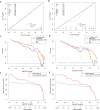Predicting tumor invasion depth in gastric cancer: developing and validating multivariate models incorporating preoperative IVIM-DWI parameters and MRI morphological characteristics
- PMID: 39175075
- PMCID: PMC11340138
- DOI: 10.1186/s40001-024-02017-w
Predicting tumor invasion depth in gastric cancer: developing and validating multivariate models incorporating preoperative IVIM-DWI parameters and MRI morphological characteristics
Abstract
Introduction: Accurate assessment of the depth of tumor invasion in gastric cancer (GC) is vital for the selection of suitable patients for neoadjuvant chemotherapy (NAC). Current problem is that preoperative differentiation between T1-2 and T3-4 stage cases in GC is always highly challenging for radiologists.
Methods: A total of 129 GC patients were divided into training (91 cases) and validation (38 cases) cohorts. Pathology from surgical specimens categorized patients into T1-2 and T3-4 stages. IVIM-DWI and MRI morphological characteristics were evaluated, and a multimodal nomogram was developed. The MRI morphological model, IVIM-DWI model, and combined model were constructed using logistic regression. Their effectiveness was assessed using receiver operating characteristic (ROC) curves, calibration curves, decision curve analysis (DCA), and clinical impact curves (CIC).
Results: The combined nomogram, integrating preoperative IVIM-DWI parameters (D value) and MRI morphological characteristics (maximum tumor thickness, extra-serosal invasion), achieved the highest area under the curve (AUC) values of 0.901 and 0.883 in the training and validation cohorts, respectively. No significant difference was observed between the AUCs of the IVIM-DWI and MRI morphological models in either cohort (training: 0.796 vs. 0.835, p = 0.593; validation: 0.794 vs. 0.766, p = 0.79).
Conclusion: The multimodal nomogram, combining IVIM-DWI parameters and MRI morphological characteristics, emerges as a promising tool for assessing tumor invasion depth in GC, potentially guiding the selection of suitable candidates for neoadjuvant chemotherapy (NAC) treatment.
Keywords: Diffusion weighted imaging; Intravoxel incoherent motion; Neoplasm staging; Nomogram; Stomach neoplasms.
© 2024. The Author(s).
Conflict of interest statement
The authors declare that they have no competing interests.
Figures






Similar articles
-
A Nomogram of Combining IVIM-DWI and MRI Radiomics From the Primary Lesion of Rectal Adenocarcinoma to Assess Nonenlarged Lymph Node Metastasis Preoperatively.J Magn Reson Imaging. 2022 Sep;56(3):658-667. doi: 10.1002/jmri.28068. Epub 2022 Jan 28. J Magn Reson Imaging. 2022. PMID: 35090079
-
Quantitative study of preoperative staging of gastric cancer using intravoxel incoherent motion diffusion-weighted imaging as a potential clinical index.Eur J Radiol. 2021 Aug;141:109627. doi: 10.1016/j.ejrad.2021.109627. Epub 2021 Mar 4. Eur J Radiol. 2021. PMID: 34126429
-
Quantitative Dynamic-Enhanced MRI and Intravoxel Incoherent Motion Diffusion-Weighted Imaging for Prediction of the Pathological Response to Neoadjuvant Chemotherapy and the Prognosis in Locally Advanced Gastric Cancer.Front Oncol. 2022 Mar 29;12:841460. doi: 10.3389/fonc.2022.841460. eCollection 2022. Front Oncol. 2022. PMID: 35425711 Free PMC article.
-
Preoperative detection of lymphovascular invasion in rectal cancer using intravoxel incoherent motion imaging based on radiomics.Med Phys. 2024 Jan;51(1):179-191. doi: 10.1002/mp.16821. Epub 2023 Nov 6. Med Phys. 2024. PMID: 37929807
-
Comparison of MRI and CT-Based Radiomics and Their Combination for Early Identification of Pathological Response to Neoadjuvant Chemotherapy in Locally Advanced Gastric Cancer.J Magn Reson Imaging. 2023 Sep;58(3):907-923. doi: 10.1002/jmri.28570. Epub 2022 Dec 17. J Magn Reson Imaging. 2023. PMID: 36527425 Clinical Trial.
Cited by
-
Multi-orientation and prone-position ZOOMit diffusion-weighted imaging for predicting T stage in distal gastric cancer.Eur Radiol. 2025 Apr 30. doi: 10.1007/s00330-025-11638-6. Online ahead of print. Eur Radiol. 2025. PMID: 40307529
-
Early Detection of Malignant Cells in Gastric Lavage via Hexokinase 2 and Single-Cell Sequencing for Gastric Cancer Diagnosis.Risk Manag Healthc Policy. 2025 Mar 25;18:1011-1021. doi: 10.2147/RMHP.S510123. eCollection 2025. Risk Manag Healthc Policy. 2025. PMID: 40161902 Free PMC article.
-
Integrative single-cell and multi-omics analyses reveal ferroptosis-associated gene expression and immune microenvironment heterogeneity in gastric cancer.Discov Oncol. 2025 Jan 17;16(1):57. doi: 10.1007/s12672-025-01798-8. Discov Oncol. 2025. PMID: 39831925 Free PMC article.
References
-
- Sung H, Ferlay J, Siegel RL, Laversanne M, Soerjomataram I, Jemal A, Global cancer statistics, et al. GLOBOCAN estimates of incidence and mortality worldwide for 36 cancers in 185 countries. CA Cancer J Clin. 2020. 10.3322/caac.21660.10.3322/caac.21660 - DOI
MeSH terms
Grants and funding
LinkOut - more resources
Full Text Sources
Medical
Miscellaneous

